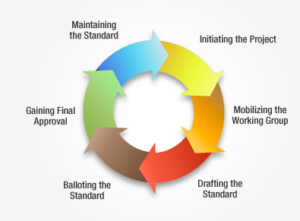 Standards are used by people around the world, in various industries and professions. From healthcare, to education, energy, construction, environment, technology and more, published specifications and procedures help maximize the reliability of materials, products, methods, and services. Standards are the foundation for the development and implementation of technologies that transform the way we live, work and communicate.
Standards are used by people around the world, in various industries and professions. From healthcare, to education, energy, construction, environment, technology and more, published specifications and procedures help maximize the reliability of materials, products, methods, and services. Standards are the foundation for the development and implementation of technologies that transform the way we live, work and communicate.
IEEE is one of several Standards Development Organizations (SDOs), which develop and maintain standards. SDOs adhere to fair and equitable processes that ensure the highest quality outputs and reinforce the market relevance of standards.
The Standards Process
While the goals of each SDO are essentially the same, each organization has its own rules, processes and terminology.
IEEE uses a time-tested, effective and trusted process. The six stages of this process lifecycle are:
- Initiating the Project. A formal request is submitted by an individual or entity (known as a Sponsoring Body) for review and evaluation.
- Mobilizing the Working Group. Once the request is approved, the sponsor follows the SDO’s rules and processes to recruit and assemble a collaborative team (IEEE refers to this team as a “Working Group”) of volunteers to engage in active standards development.
- Drafting the Standard. The team members engage in meetings, draft and review position pieces, create and review presentations, examine data and engage in active discussion and debate to resolve outstanding issues. All this leads to the gradual definition of each standard, which is compiled into a draft standard that may undergo multiple revisions.
- Balloting the Standard. Once a draft standard has been finalized, reviewed and approved by the Working Group, it’s submitted to the sponsor who forms a balloting group consisting of persons interested in the standard. Group members will comment, discuss and then vote to approve the standard.
- Gaining Final Approval. The balloted draft is submitted to the Review Committee and then to the Standards Board for approval. Once it’s reviewed and accepted, the approved standard is published and made available for distribution and purchasing within a number of outlets, including through the SDO itself.
- Maintaining the Standard. Standards are “living documents,” which may be initially published and iteratively modified, corrected, adjusted and/or updated based on market conditions and other factors.
Mars Space Colony: A Game of Standardization
IEEE offers an exciting, hands-on, team-building experience that teaches how standards are developed. Check out Mars Space Colony: A Game of Standardization. It’s crafted by experts with 20+ years’ experience in high-stakes, real-world technical standards development.


No comments yet.